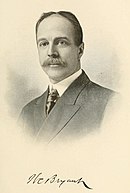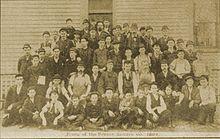| Company type | Private |
|---|---|
| Industry | Electrical components, Switches |
| Founded | 1888; 137 years ago (1888) |
| Defunct | 1988; 37 years ago (1988) |
| Fate | Acquired by Hubbell Incorporated |
| Successor | Hubbell Incorporated |
| Headquarters | Bridgeport, Connecticut |
| Key people | Waldo Calvin Bryant, Founder |
| Number of employees | 1,600 |
| Parent | Westinghouse Electric Corporation (1901-1927) |
The Bryant Electric Company was a manufacturer of wiring devices, electrical components, and switches founded in 1888 in Bridgeport, Connecticut. It grew to become for a time both the world's largest plant devoted to the manufacture of wiring devices and Bridgeport's largest employer and was involved in a number of notable strikes, before being closed in 1988 and having its remaining interests sold to Hubbell in 1991.
Founding and growth

Bryant was founded by Waldo Calvin Bryant in 1888 (incorporated 1889) in Bridgeport, Connecticut, with seven employees working in a loft on John Street in Bridgeport. Waldo Bryant and others at Bryant invented and patented a number of switch and electrical component designs, including "the first push-pull switch". Although responsible for more than 500 patents by 1935, Bryant's most significant contribution to the wiring devices industry was the idea of standardization. For example, in 1888 there were eight different types of electrical light bases. Bryant led the industry to accept standardized devices.
Bryant grew quickly and, in 1890, acquired the Standard Electric Time Company and Empire China Works. In 1891, Bryant relocated to a former school building owned by P. T. Barnum off State Street and, by 1905, employed 700 people. Perkins Electric Switch Company was acquired in 1899, with the employees and plant relocating to Bridgeport. Waldo Bryant needed more capital for expansion and sold the majority interest to Westinghouse Electric in 1901, though he continued to run the company as the Bryant Electric subsidiary of Westinghouse until 1927. One reason for downplaying the Westinghouse ownership was to keep Bryant distributors who had exclusive franchises to sell products of Westinghouse's competitors from dropping the Bryant line.
For a time, Bryant was Bridgeport's largest employer and, by 1912, its 200,000-square-foot (19,000 m) plant in Bridgeport's West End neighborhood was the largest in the world "devoted exclusively to the manufacture of wiring devices". As electrical components began to be made with plastic, Bryant acquired Hemco Plastics Company in 1928. By that year, Bryant was selling over 4,000 different products. By 1938, the plant had grown to 500,000 square feet (46,000 m) and employed 1,537 people, increased to 1,600 in 1946.
Labor relations

At the time of Bryant's founding and rapid growth Bridgeport's West End was a dense, congested working-class neighborhood and a large population of mostly Hungarian immigrants, as well as Swedes, Slovenians and French Canadians, lived to the south of the industrial zone where Bryant was located. Subsequently, a large number of Hungarians were employed by the company in its early days. In 1944, in an effort to maintain good relations with its Hungarian employees, Bryant transferred a strip of land to the Hungarian Reformed Church to be used for construction of a basketball court, gymnasium and auditorium.
Workers at the Bryant plant were involved in a number of notable strikes over the years, including a 1915 strike when a number of Bridgeport companies were closed down amid demands for union representation and an eight-hour day and a 1955 United Electrical Workers strike over working conditions and pay.
1915 strike
While thousands took part in the Bridgeport strikes of 1915, few were actually union members and many were women who had been denied membership in craft unions. The Bryant Electric strike was started by five hundred women assemblers and a handful of men who walked off the job on August 20, marched downtown for a mass meeting at Eagle's Hall and elected a strike committee with equal representation for women. The company responded by shutting the plant and charging the strikers with "rioting." The remaining two thirds of the plant joined the strikers and after two weeks the company acceded to the workers' demands for an eight-hour day, overtime pay and union representation.
Deindustrialization and plant closing
As part of a larger process of regional deindustrialization, Westinghouse shut down the Bryant Electric plant in 1988 after transferring most of the work to non-union plants in North Carolina, Puerto Rico and the Dominican Republic. The closing exacerbated the neighborhood's already bleak economic situation. Westinghouse sold its remaining interests in Bryant Electric to Hubbell Incorporated in 1991 with the rebranded Distribution and Controls Business Unit going to Eaton in 1994. Bryant's 20-building, 6-acre (24,000 m) site in Bridgeport's West End was torn down in 1996 to make way for a new industrial park.
See also
References
- "Hubbell Inc, Form 10-K, Filing Date Dec 03/25/1994". edgar.secdatabase.com.
- "Hubbell, Inc hosting website".
- ^ "Patent History Of Socket And Switch Manufacturers, Inventors And Their Inventions". Antique Light Sockets. Retrieved 2009-09-02.
- U.S. patent 391,943
- *Waldo, George Curtis (1917). History of Bridgeport and Vicinity, Volume 2. S. J. Clarke. p. 90.
- ^ Kearns, Betsy; Kirkorian, Cece Saunders; Bedford, Steven; Stewart, Robert C. (May 1995). "Bryant Electric Company" (PDF). Historic American Engineering Record. Washington, D.C.: Library of Congress. pp. 2–10. Retrieved 2015-01-25.
- "Bryant Electric Company". Bridgeport Herald. July 9, 1905. Retrieved 2010-07-06.
- "W. G. Bryant Dies; Bridge Port Banker; Chairman of Electrical Company and Inventor Succumbs at 66 in Colorado Springs". The New York Times. July 6, 1930. Retrieved 2010-07-06.
- ^ "Bryant Electric Company". Bridgeport Public Library. Archived from the original on 2011-07-25. Retrieved 2009-08-21.
- "More Bridgeport Strikes: About 3,000 Workers Out Now, and More Threaten to Quit". The New York Times. 1915-08-21. Retrieved 2009-09-02.
One-half of the employes of the Bryant Electric Company walked out on a strike this morning without making any demand on the company. Two hours later the operatives, with the exception of one cutter, at the Star Shirt Factory followed suit. Later in the day the strikers formulated demands for an eight-hour day and an increase in wages, which were presented to the companies.
- "Union, Company Tell Own Stands". Sunday Herald (Bridgeport). 1955-11-06. Retrieved 2010-07-06.
- ^ "Oral History Project: "Bridgeport Working: Voices from the 20th Century" Alfred Salamanca interviewed by Barbara Hall, December 10, 1997" (PDF). Bridgeport Public Library. 1997-12-10. pp. 9, 11. Archived from the original (PDF) on 2011-07-25. Retrieved 2009-09-02.
- Foner, Philip Sheldon (1982). History of the Labor Movement in the United States: 1915-1916, on the Eve of America's Entrance into World War I, Vol. 6. International Publishers Company, Incorporated. pp. 195–196. ISBN 978-0-7178-0595-2.
- "Sky is Clearing in Bridgeport". Meriden Morning Record. 1915-09-01. Retrieved 2010-07-06.
The return to work of the 1500 employees of the Bryant Electric Company tomorrow was definitely arranged. The men get the eight hour day ... and recognition of the union.
- Brown, Carrie (2002). Rosie's Mom: Forgotten Women Workers of the First World War. Northeastern. pp. 52–54. ISBN 978-1-55553-535-3.
- Varnon, Rob (May 31, 2004). "Bridgeport, Conn., Employers Mirror Decline of American Manufacturing". Connecticut Post. Archived from the original on November 4, 2012. Retrieved 2010-07-06.
In the 1940s, Bridgeport was a booming industrial city. In 2004 it appears to be a shadow of its former self, with many of its former big employers gone, their buildings either shuttered or replaced with retail shops.
- "Bryant Electric Company: A Proud History". Hubbell Inc. Archived from the original on 2008-10-13. Retrieved 2009-08-22.
- "Westinghouse Completes Sale of Distribution & Control Business". Bloomberg. February 1994.
External links
- Bridgeport Working: Voices from the 20th Century - Bridgeport Public Library
- Keep Bryant In Bridgeport Photograph (1986)
- Historic American Engineering Record (HAER) No. CT-155, "Bryant Electric Company, 1421 State Street, Bridgeport, Fairfield County, CT", 33 photos, 29 data pages, 5 photo caption pages
- HAER No. CT-155-A, "Bryant Electric Company, Building No. 24, 80 Organ Street", 11 photos, 4 data pages, 2 photo caption pages
- HAER No. CT-155-B, "Bryant Electric Company, Building Nos. 22, 25 & 32, 623 Hancock Avenue", 3 photos, 4 data pages, 2 photo caption pages
| Westinghouse | ||||||||||||||
|---|---|---|---|---|---|---|---|---|---|---|---|---|---|---|
| Westinghouse Electric Corp. (1886–2000) |
|  | ||||||||||||
| Related companies | ||||||||||||||
- Westinghouse Electric Company
- Electrical engineering companies of the United States
- Defunct manufacturing companies based in Connecticut
- Companies based in Bridgeport, Connecticut
- Electronics companies established in 1888
- 1888 establishments in Connecticut
- History of labor relations in the United States
- Labor disputes in the United States
- Historic American Engineering Record in Connecticut
- 1991 mergers and acquisitions
- Electrical equipment manufacturers